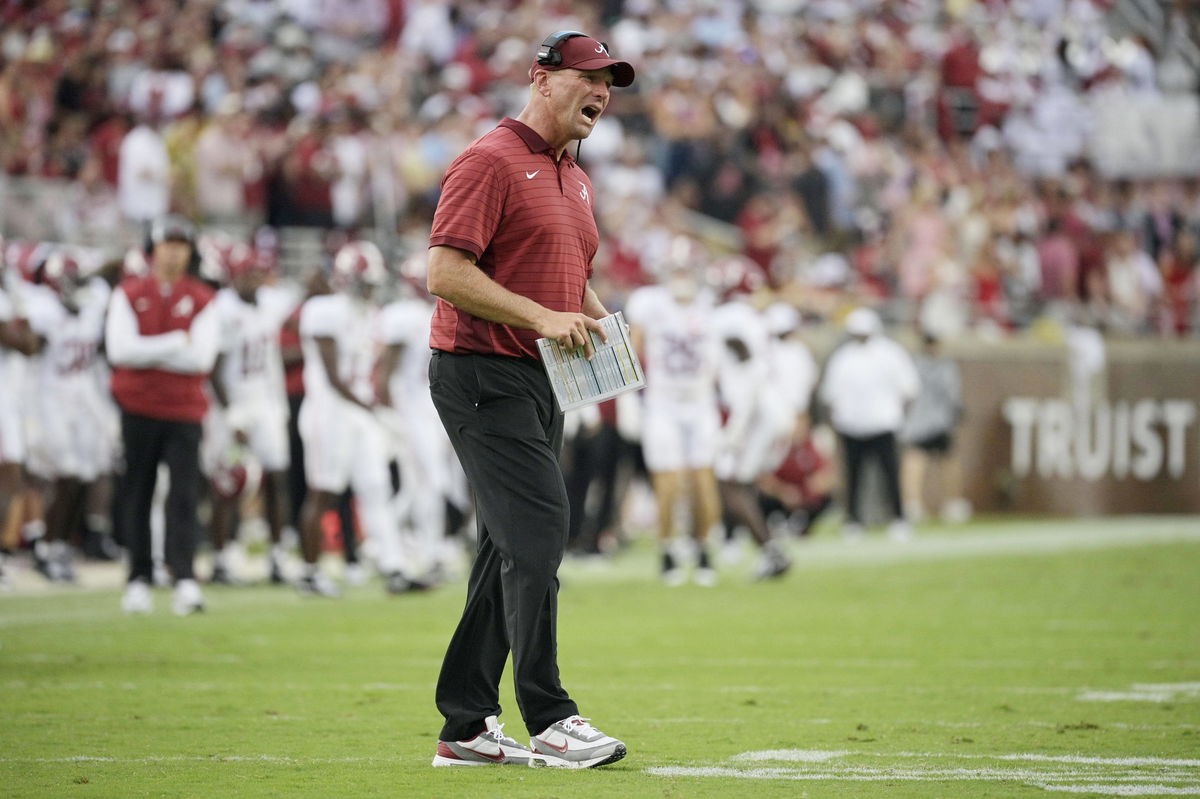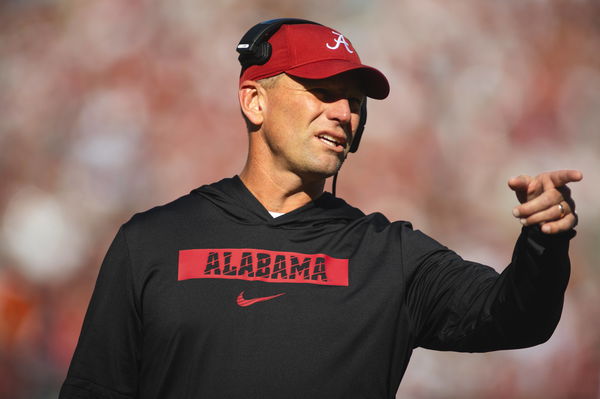
Imago
NCAA, College League, USA Football: Alabama at Florida State Aug 30, 2025 Tallahassee, Florida, USA Alabama Crimson Tide head coach Kalen DeBoer reacts after a play against the Florida State Seminoles during the second half at Doak S. Campbell Stadium. Tallahassee Doak S. Campbell Stadium Florida USA, EDITORIAL USE ONLY PUBLICATIONxINxGERxSUIxAUTxONLY Copyright: xMelinaxMyersx 20250830_jcd_av1_0075

Imago
NCAA, College League, USA Football: Alabama at Florida State Aug 30, 2025 Tallahassee, Florida, USA Alabama Crimson Tide head coach Kalen DeBoer reacts after a play against the Florida State Seminoles during the second half at Doak S. Campbell Stadium. Tallahassee Doak S. Campbell Stadium Florida USA, EDITORIAL USE ONLY PUBLICATIONxINxGERxSUIxAUTxONLY Copyright: xMelinaxMyersx 20250830_jcd_av1_0075
Twenty-two months ago, Courtney Morgan was caught between two worlds: he was watching his own alma mater, Michigan, play with players he had scouted, and he was enjoying a national title run he had helped construct at Washington. A week later, he and Kalen DeBoer headed to Tuscaloosa in an attempt to stabilize a program that is still plagued by Nick Saban‘s shadow.
Watch What’s Trending Now!
At Washington, Morgan held a similar hybrid personnel/GM role and helped DeBoer flip a 4–8 program into a 25–3 monster with a Pac-12 title and CFP title-game trip in just two seasons. Before that, he ran roster building at Michigan and Fresno State, both of which made major jumps under his watch.
Now, Alabama’s 8-1 start feels more like the product of a GM who has perfected retention and portal strategy. The true twist behind that comeback is Morgan’s belief that he can build a championship lineup for DeBoer at a very specific cost, which could totally disrupt the NIL economy. “My whole life, it’s just been something I’ve always wanted to do,” Morgan said. “I’m actually living the dream.”
ADVERTISEMENT
Courtney Morgan will tell you that Alabama’s rapid self-reconstruction began in the locker room rather than the transfer portal. He loves to question, “Is the answer to what we’re trying to solve already on our roster? (Or will we) risk taking a guy in the portal and paying more money?” Most of the time this year, the response was a yes. In the chaotic roster market of 2025, simply retaining more than a dozen starters is rare. Alabama kept 14 of them on board. But Morgan never panicked. Alabama secretly examined its own players like an NFL front office, while the rest of the nation viewed the portal as a discount sale.

Imago
NCAA, College League, USA Football: Tennessee at Alabama Oct 18, 2025 Tuscaloosa, Alabama, USA Tennessee Volunteers running back Peyton Lewis 2 runs with the ball in the fourth quarter against the Alabama Crimson Tide at Saban Field at Bryant-Denny Stadium. Tuscaloosa Saban Field at Bryant-Denny Stadium Alabama USA, EDITORIAL USE ONLY PUBLICATIONxINxGERxSUIxAUTxONLY Copyright: xDavidxLeongx 20251018_kdn_gj7_114
According to Alabama’s staff bio, Morgan’s first full offseason ended with 38 letterwinners and 14 starters retained from the previous team, while still signing a top-3 high school recruiting class and adding 10 portal players. For a staff change at a blue-blood, that kind of continuity is unusually high in an era where double-digit starter losses have become normal.
ADVERTISEMENT
“So whoever evaluates their roster the best are the teams that are gonna be fiscally responsible in the portal. If you look at our wide receiver room, we lost four, but we brought in three (transfer Isaiah Horton and freshmen Lotzeir Brooks and Derek Meadows), but it was the right three for what we do and our room has been totally upgraded,” he said.
That efficiency extends straight to the portal. For Morgan, paying for production is more important than chasing big names. Only a few of the thirty guys on the list meet Alabama’s physical standards, and maybe seven are even worth talking about. That’s his master plan. And that’s exactly where the “money side” kicks in. The part where Morgan insists you can build a championship roster for about $27 million if you know exactly what you’re paying for.
ADVERTISEMENT
For context, Texas is reportedly preparing to spend $35–40 million on its 2025 roster, combining the new revenue-sharing model with its NIL collective. Ohio State’s 2024 national title roster was estimated at around $20 million.
Under the House v. NCAA framework, SEC schools are expected to max out the $20.5 million annual revenue-sharing cap with athletes, with roughly $15.1 million of that going to football alone. Morgan’s $27 million model effectively says: add a lean, targeted NIL layer on top of that cap, and you can still hang with programs flirting with $35–40 million “rosters” if you don’t whiff in evaluation.
The modern GM position combines elements of a long-term architect, economist, therapist, and scout. Morgan discusses positional worth, salaries, and potential repercussions in the same manner that NFL general managers do during Combine week. Also, he is playing on a much larger chessboard now that revenue sharing gives Alabama complete control over compensation. The goal? Spend wisely everywhere else, but aggressively where it counts.
ADVERTISEMENT
That’s why his line hit like a thunderclap: “If you do it right, you can really get a championship roster built for $27 million.” Morgan thinks Alabama can outperform the competition by being sharper rather than louder in a time when coaches are whispering about $35 million and even $40 million rosters. It’s a national-title blueprint based on productivity, intuition, retention, and just the right amount of financial courage. It’s the ultimate Kalen DeBoer-era flex. The GM in Tuscaloosa is systematically drafting up a $27 million master plan to fuel the next roaster, while the rest of the SEC may be inflating the market. But that bold $27 million thesis landed right as Alabama was battling his own financial storm.
The $27.9M storm that pushed Alabama into a new era
At that point, fans thought the sky was falling when they saw the $27.9 million net loss, but inside the office, it seemed more like a chaotic reset than a collapse. Kalen DeBoer entered Tuscaloosa with a feeling that Year 1 would be expensive due to buyouts, new hiring, support personnel, and the entire transition bill. The school referred to it as “one-time expenses,” but it didn’t feel that way to fans who watched athletes hitting the portal.
ADVERTISEMENT
The actual report showed $234 million in operating revenue vs. $262 million in expenses for Alabama athletics, with the school explicitly labeling the shortfall as “largely due to one-time expenses associated with the football coaching transition.” Football itself still posted a $26.4 million profit, down from $46 million the year before, as coaching salaries and support-staff costs spiked.

Imago
Landing Elijah Haven would add depth to HC Kalen DeBoer’s 2027 Alabama team.
It appeared more like a full-fledged evacuation than a coaching change when nine players left immediately following the ReliaQuest Bowl, and another fifteen had already left before. The majority of this change began long before the bowl defeat, even before it made headlines. Danny Lewis, a tight end, left before the team arrived in Tampa. Caleb Odom, Jahlil Hurley, and Kobe Prentice were among the early departing players who weren’t waiting to see what Kalen DeBoer’s system would look like in Year 2. What was already developing beneath ReliaQuest was just intensified. The roster that the new staff had taken over was built for an entirely different era of Alabama football.
That’s why Courtney Morgan’s roster philosophy suddenly hits with a different meaning. He discussed how a championship team might be assembled “for about $27 million if you do it right.” But back in Jan, Alabama didn’t have the luxury of pouring money at every opening because financial reports were showing red ink and the portal was draining the depth chart. They needed NFL-level selectivity and retention. The losses in the locker room, on the field, and on the balance sheet forced Alabama to rebuild more wisely. And surprisingly enough, Morgan’s plan works best in that type of setting.
The early return is that it is working. An 8–1 start with a roster that retained 14 starters, survived 23 portal exits, and leaned on a selective class of 10 transfers is basically the proof-of-concept for his $27 million thesis: you don’t have to “win” every bidding war if you’re ruthless about who you keep and exactly what you’re paying for.
ADVERTISEMENT
ADVERTISEMENT
ADVERTISEMENT

